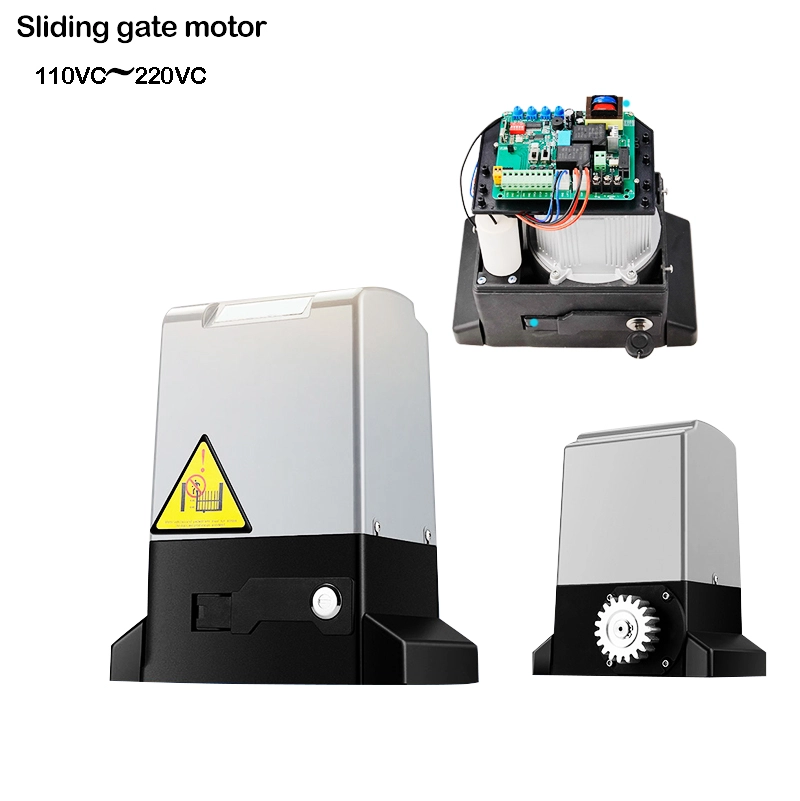Sliding door motors are a critical innovation in modern building design, enhancing both functionality and aesthetics. Whether for residential, commercial, or industrial use, these systems offer convenience, space-saving solutions, and improved accessibility. In this article, Fuyuntech will explore the essential features and benefits of sliding door motors, as well as provide insights into how to maintain them for optimal performance.

Why Choose Sliding Door Motors?
There are several reasons why people choose to install sliding door motors in their homes, offices, or businesses. These benefits range from convenience to security, making the motors an essential component in today's buildings.
1. Convenience and Accessibility
Sliding door motors offer a level of convenience and accessibility that is unmatched by traditional door systems, particularly for individuals with disabilities or limited mobility. Automated sliding doors, which open with the push of a button or through motion sensor activation, provide a hands-free solution, making it easier for people in wheelchairs, those with walkers, or individuals carrying heavy items to navigate through spaces without the need for assistance.
In high-traffic commercial settings such as airports, shopping malls, and hospitals, sliding door motors contribute significantly to maintaining a smooth flow of people. The automatic opening and closing of the doors reduce the physical effort required to move between rooms or buildings. This increased ease of access helps improve the overall experience for visitors, customers, and patients, ensuring that they encounter fewer barriers in their daily routines.
Moreover, sliding door motors are ideal for environments where people with varying levels of mobility need to move freely. The automated systems ensure that doors open smoothly and efficiently without the need for manual operation, which can be particularly challenging for elderly individuals or those with physical disabilities. This capability ensures that everyone, regardless of mobility, can access the space with ease and without inconvenience.
2. Space-Saving Design
One of the standout benefits of sliding door motors is the space-saving design they offer, particularly in smaller rooms or spaces where every inch counts. Unlike traditional hinged doors, which require space to swing open, sliding doors glide along a track, making them ideal for areas with limited space. Sliding door motors enhance this feature by providing smooth, silent operation, allowing doors to open and close seamlessly without disturbing the surrounding environment.
For spaces with high ceilings or narrow hallways, sliding door motors present an elegant and functional solution. The ability to install doors that don't intrude into the available room space allows for better flow and greater usability. This makes them perfect for modern architectural designs that aim to maximize the use of space while maintaining a sleek, open aesthetic.
In commercial settings like hotels or offices where space is often at a premium, sliding door motors are invaluable in providing optimal functionality without compromising on design. They help create an open, airy atmosphere while still providing the necessary privacy and separation between rooms.
3. Energy Efficiency
Energy efficiency is another compelling reason to invest in sliding door motors. Automated sliding doors help maintain a controlled internal environment by effectively sealing the space when not in use. This is particularly important for managing indoor temperatures, as sliding doors close tightly, reducing the escape of heat or air conditioning. As a result, these systems reduce energy loss, helping to lower energy consumption and keep utility costs down.
In office buildings, restaurants, and commercial spaces where energy usage is typically higher, sliding door motors offer substantial savings by minimizing energy waste. When the doors are closed, they create an airtight seal, which keeps indoor temperatures consistent and prevents drafts. This can be especially useful in buildings with large open spaces, where maintaining a stable temperature is crucial for comfort and cost management.
In colder climates, sliding door motors can significantly reduce the load on heating systems, while in warmer regions, they help retain cool air. This ability to improve energy efficiency not only contributes to lower operational costs but also supports environmentally friendly building practices, which are becoming increasingly important for businesses and homeowners alike.
4. Enhanced Security
Security is a top priority in both residential and commercial properties, and sliding door motors can enhance security by integrating advanced features like motion sensors, automated locks, and self-closing mechanisms. These features are designed to protect occupants and assets by ensuring that doors are securely closed after each use.
Many sliding door motors are equipped with automatic locking mechanisms that engage when the door is closed, preventing unauthorized access. This is particularly beneficial in high-traffic areas where individuals may forget to manually lock the door after entering or exiting. Additionally, for residential properties, sliding door motors can be paired with home security systems to provide further protection.
In high-security environments, such as banks, research facilities, or data centers, sliding door motors can be integrated with alarm systems or surveillance cameras, enhancing the level of security without sacrificing convenience. These advanced systems allow the door to operate autonomously while providing real-time monitoring, ensuring that unauthorized access attempts are immediately detected. The automation of these systems ensures that security is never compromised, even when the building is unstaffed.
Installation and Maintenance of Sliding Door Motors
Proper installation and regular maintenance are critical for ensuring the long-term performance and reliability of sliding door motors. Whether for residential or commercial use, these systems must be installed correctly and maintained regularly to function optimally. Below are the essential steps for installation, ongoing maintenance, and troubleshooting common issues with sliding door motors.
1. Installation Process
The installation of a sliding door motor requires careful planning and execution, and it is always recommended to have the process carried out by professionals. Proper installation ensures the system operates smoothly and safely, reducing the risk of future issues.
The process typically starts with securely mounting the sliding door motor onto the door frame. This requires precise alignment to ensure the motor is positioned correctly and can handle the weight and movement of the door. The door tracks must also be aligned properly to facilitate smooth door movement. If the tracks are not level or aligned correctly, it can lead to unnecessary wear on the sliding door motor, resulting in premature failure or inefficient operation.
Additionally, the electrical system must be configured to meet the motor's power requirements. This often involves wiring the motor to a power source, ensuring that it is connected to sensors or remote controls if applicable. Advanced sliding door motors may come with built-in features such as motion sensors, remote control capabilities, or smartphone connectivity, which need to be integrated during the installation process. It's also essential to test the system thoroughly after installation to ensure all components are working as expected before the door is used regularly.
2. Regular Maintenance
Maintaining your sliding door motor is essential for ensuring its long-term reliability and efficiency. Regular maintenance not only extends the life of the motor but also minimizes the risk of breakdowns that can disrupt your day-to-day activities. Here are key maintenance tasks to perform regularly:
-
Lubricating the Door Tracks: Over time, friction can cause the door tracks to wear down, resulting in poor performance. To keep the door moving smoothly, it's essential to lubricate the tracks regularly. Use a lubricant recommended by the manufacturer, and apply it evenly along the tracks to ensure smooth and quiet operation.
-
Checking the Motor for Wear: Inspect the sliding door motor for any signs of wear, such as unusual sounds or difficulty in opening and closing the door. A motor that is underperforming may require cleaning, tightening of components, or lubrication to ensure optimal functionality. Over time, components like gears and belts can wear out, so it's important to replace them before they cause a complete system failure.
-
Sensor Maintenance: If your sliding door motor includes sensors, it's important to ensure they are clean and functioning correctly. Dirty or misaligned sensors can prevent the door from opening or closing properly, posing safety risks. Periodically clean the sensor lenses and check for any obstructions in the sensor's path.
-
Cleaning Components: Dust, dirt, and debris can accumulate on both the door and motor components, which can affect the system's performance. Regular cleaning prevents dirt buildup and ensures smooth operation. Wipe down the motor and door components with a soft cloth to avoid damaging the surface.
3. Troubleshooting Common Issues
Despite regular maintenance, sliding door motors may occasionally experience issues. Understanding common problems and their potential solutions can help address these issues before they cause significant disruptions. Below are some common problems and troubleshooting tips:
-
Door Misalignment: One of the most common issues is door misalignment. If the door is not properly aligned with the tracks, it can cause the motor to strain and operate inefficiently. This misalignment can be caused by wear and tear, improper installation, or external factors such as temperature changes. Regularly check the alignment of the door tracks and adjust as necessary to ensure the door moves smoothly along the tracks.
-
Motor Malfunction: If the sliding door motor is not responding or is making unusual sounds, it may be malfunctioning. The issue could be related to the motor itself, the wiring, or an internal component such as a gear or belt. In such cases, it is essential to contact a professional technician to diagnose and repair the motor. Attempting to fix the motor without proper knowledge can result in further damage.
-
Sensor Failure: If the door does not open or close as expected, sensor failure could be the cause. Sensors can become dirty, misaligned, or damaged over time, preventing them from detecting movement correctly. To resolve this issue, check the sensors for obstructions, clean the sensor lenses, and ensure they are correctly aligned. If the sensors appear damaged, consider replacing them.
In any of these cases, it's essential to address the problem promptly. While minor issues can often be fixed with simple maintenance, more complex problems should be handled by trained professionals. Regular inspections and prompt repairs can save you time and money by preventing more serious issues from developing.
Sliding door motors are an excellent choice for enhancing the functionality and aesthetics of any space. Whether for residential, commercial, or industrial applications, these systems provide unparalleled convenience, energy efficiency, and security. By choosing the right motor, maintaining it properly, and ensuring it meets your specific needs, you can enjoy the benefits of smooth and reliable sliding door operations for years to come.
https://www.fuyuntechbest.com/Sliding-Door-Motors-The-Future-of-Automated-Door-Systems.html
https://www.fuyuntechbest.com/Sliding-Gate-Opener
www.fuyuntechbest.com
Dongguan Fuyun Electronic Technology Co., Ltd.
About Author
You may also like
-
Troubleshooting and Solutions for Common Galvanized Steel Pipe Issues
-
Key Features of Laminated Double Glazing for Modern Buildings August 2025 – Architectural News Report
-
A Complete Guide to Using Reusable Waffle Formwork Efficiently
-
How Ground Strengthening Prevents Structural Settlement in Urban Projects
-
Leading the Future of Construction: The Role of a Modular Building Manufacturer
